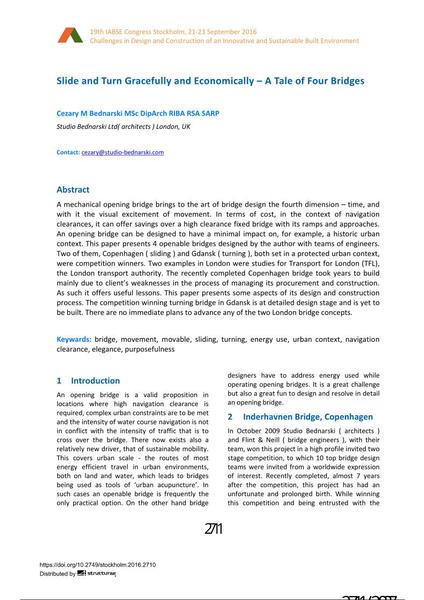Slide and Turn Gracefully and Economically – A Tale of Four Bridges

|
|
|||||||||||
Bibliografische Angaben
| Autor(en): |
Cezary Marek Bednarski
(Studio Bednarski Ltd( architects ) London, UK)
|
||||
|---|---|---|---|---|---|
| Medium: | Tagungsbeitrag | ||||
| Sprache(n): | Englisch | ||||
| Tagung: | IABSE Congress: Challenges in Design and Construction of an Innovative and Sustainable Built Environment, Stockholm, Sweden, 21-23 September 2016 | ||||
| Veröffentlicht in: | IABSE Congress Stockholm, 2016 | ||||
|
|||||
| Seite(n): | 2711-2718 | ||||
| Anzahl der Seiten (im PDF): | 8 | ||||
| Jahr: | 2016 | ||||
| DOI: | 10.2749/stockholm.2016.2710 | ||||
| Abstrakt: |
A mechanical opening bridge brings to the art of bridge design the fourth dimension – time, and with it the visual excitement of movement. In terms of cost, in the context of navigation clearances, it can offer savings over a high clearance fixed bridge with its ramps and approaches. An opening bridge can be designed to have a minimal impact on, for example, a historic urban context. This paper presents 4 openable bridges designed by the author with teams of engineers. Two of them, Copenhagen ( sliding ) and Gdansk ( turning ), both set in a protected urban context, were competition winners. Two examples in London were studies for Transport for London (TFL), the London transport authority. The recently completed Copenhagen bridge took years to build mainly due to client’s weaknesses in the process of managing its procurement and construction. As such it offers useful lessons. This paper presents some aspects of its design and construction process. The competition winning turning bridge in Gdansk is at detailed design stage and is yet to be built. There are no immediate plans to advance any of the two London bridge concepts. |
||||
| Stichwörter: |
Brücke Energienutzung Gleiten
|
||||
